#Remove toxic chemicals from water
Text
The Ultimate Guide to Shower Filters to Remove Toxic Chemicals
Discover the secrets to healthier showers with our comprehensive guide on shower filters! Learn how to remove toxic chemicals, combat hard water, and improve hair and skin health. Dive in for expert advice and make every shower a rejuvenating experience.
Water purification systems
When it comes to maintaining a healthy lifestyle, water plays a crucial role. We use water not only for drinking but also for various household activities such as cooking, cleaning, and bathing. However, what most people are not aware of is that the water coming into our homes may contain harmful chemicals and impurities that can have negative effects on our health.…

View On WordPress
#ascorbic acid to remove chlorine#berkey shower filter#best rated shower filters#best shower filter#Best shower filters#cheapest way to remove iron from well water#Clean water solutions#Expert advice on shower filters#Hard water shower filter#Healthier showers#How to choose a shower filter#how to filter shower water#how to install a chlorine free shower filter#how to install shower filter for hard water#how to remove chlorine#Importance of water filtration#remove chemicals from water#Remove toxic chemicals from water#Shower Filter#Shower filter benefits#Shower filter for hair and skin#shower filter review#Shower filter reviews#Shower filters#shower head filter#shower water filter#water filter#Water filtration systems#Water purification technology#Water quality improvement
0 notes
Text
"Despite a huge amount of political opposition from the chemical industry, the US Environmental Protection Agency (EPA) announced its first regulations aimed at limiting quantities of PFAs, or ‘forever chemicals,’ in American drinking water.
For decades, Polyfluoroalkyl substances or PFAs have been used for coatings that resist fire, oil, stains, and water and are now found in a wide variety of products like waterproof clothing, stain-resistant furniture, food packaging, adhesives, firefighting spray foams, and non-stick cooking surfaces.
There are thousands of PFAS compounds with varying effects and toxicity levels, and the new EPA regulations will require water utilities to test for 6 different classes of them.
The new standards will reduce PFAS exposure—and thereby decrease the health risk—for 100 million people in the U.S.
A fund worth $1 billion for treatment and testing will be made available to water utilities nationwide—part of a $9 billion investment made possible by the 2021 Bipartisan Infrastructure Law to assist communities impacted by PFAS contamination.
“Drinking water contaminated with PFAS has plagued communities across this country for too long,” said EPA Administrator Michael S. Regan in a statement Wednesday.
Under Regan’s leadership, the EPA began in 2021 to establish a roadmap for dealing with widespread PFAS contamination, and so far they’ve gathered much data, including monitoring drinking water, and begun requiring more reports from businesses about use of the unregulated substances.
The agency reported that current peer-reviewed scientific studies have shown that exposure to certain levels of PFAS may lead to a myriad of health issues that are difficult to specify because of the variety of compounds coming from different places.
Regardless, the 66,000 water utility operators will have five years to test for the PFAS pollution and install necessary technology to treat the contamination, which the EPA estimates that 6%–10% of facilities will need. [Note: Deeply curious where they got a number that low, but anyway.]
Records show that some of the manufacturers knew these chemicals posed health hazards. A few major lawsuits in recent years have been settled that sought to hold chemical companies, like 3M, accountable for the environment damage.""
-via Good News Network, April 13, 2024
#united states#pfas#forever chemicals#epa#environmental protection agency#water quality#water pollution#clean water#good news#hope
479 notes
·
View notes
Text
Cottage Witch, Common Sense
Part 2 Here
Requested by @jasper-pagan-witch
DO NOT MIX CLEANING SUPPLIES! These are chemicals we are talking about, you don't want to accidentally make a toxic fume that would be harmful to you or your pets.
Put salt in your water before boiling noodles, and a cap of olive oil. The salt helps it cook better, the oil keeps the noodles from sticking.
In a pinch white vinegar works as a disinfectant.
Use some baking soda to keep your fridge smelling fresh.
Wash your white clothes in hot water and your colored clothes in cold water. AND DON'T USE BLEACH IN YOUR COLORS.
If you are washing something that is supposed to be absorbant (towels, cloths, washable puppy pads or fleece guinea pig bedding, etc) do not use fabric softener, it will make it less observant.
DO NOT POUR OIL DOWN THE SINK! It will clog the whole freaking system!
The box is a suggestion, if your noodles need more water to finish cooking, then add some more.
Peroxide removes blood stains from clothing.
White wine removes red wine stains
I have a ton of others but these are the ones from the top of my head!
2K notes
·
View notes
Text
Eco-Friendly Cleaning Products: Safe Alternatives for Your Home
Keeping your home clean and safe doesn’t have to come at the expense of the environment. Traditional cleaning products often contain harmful chemicals that can negatively impact your health and the planet. Switching to eco-friendly cleaning products is a great way to maintain a clean home while being kind to the environment. Here are some safe alternatives you can try:
Vinegar and Baking Soda
All-Purpose Cleaner: Mix equal parts water and white vinegar in a spray bottle for a versatile cleaner that can tackle countertops, sinks, and more. Add a few drops of essential oil for a pleasant scent.
Scrubbing Paste: Combine baking soda with a small amount of water to create a paste that can scrub away tough stains in the bathroom or kitchen.
Castile Soap
Multipurpose Cleaner: Castile soap is a plant-based soap that can be used for everything from washing dishes to cleaning floors. Dilute it with water for various cleaning tasks.
Foaming Hand Soap: Mix Castile soap with water and a few drops of essential oil in a foaming soap dispenser for a gentle and effective hand soap.
Lemon Juice
Natural Disinfectant: The acidity of lemon juice makes it a powerful natural cleaner. Use it to disinfect cutting boards, clean glass, and remove stains.
Deodorizer: Add lemon juice to your cleaning routine to naturally deodorize and freshen up your home.
Hydrogen Peroxide
Disinfectant: Hydrogen peroxide is an effective disinfectant that can be used to clean surfaces, sanitize cutting boards, and whiten grout. Use a spray bottle for easy application.
Laundry Whitener: Add hydrogen peroxide to your laundry to brighten whites and remove stains without the harshness of bleach.
Essential Oils
Antimicrobial Properties: Essential oils like tea tree, lavender, and eucalyptus have natural antimicrobial properties. Add a few drops to your cleaning solutions for an extra boost.
Aromatherapy: Use essential oils in your cleaning routine to create a pleasant and calming environment in your home.
Eco-Friendly Store-Bought Products
Green Brands: Look for cleaning products from brands that prioritize sustainability and use natural, non-toxic ingredients. Brands like Seventh Generation, Method, and Ecover offer a wide range of eco-friendly cleaning products.
Refillable Options: Choose products that come in refillable containers to reduce plastic waste.
Reusable Cleaning Tools
Microfiber Cloths: Replace disposable paper towels with reusable microfiber cloths. They are effective at picking up dirt and can be washed and reused multiple times.
Natural Sponges: Opt for natural sponges or scrubbers made from sustainable materials instead of synthetic ones.
Switching to eco-friendly cleaning products is a simple yet impactful way to create a healthier home and contribute to a more sustainable future. By using natural ingredients and choosing environmentally friendly brands, you can keep your home sparkling clean without compromising your health or the planet.
Do you have any favorite eco-friendly cleaning tips or products? Share your recommendations in the comments below!
48 notes
·
View notes
Text
Period Products 101
There isn't much sex education in the US and Canada, so here's some information on period products.
I'm going over the common disposable and reusable period products, how to use them safely, what is most accessible for people with disabilities, if they can be used with an IUD, and if you can have sex with them in.
Pads and Tampons
Pads are a disposable period product placed on the underwear and worn outside the body. For boy-shorts and boxers, use pads without wings.
Tampons are a disposable period product inserted into the vagina to prevent blood from leaking outside the body. They are also safe to use in water and during physical activity.
Both tampons and pads can hold approximately 10-15 mL of fluid. Note that tampons should be worn to near saturation to prevent pain on removal. Pads and tampons can be safely worn for 4–8 hours. Be sure to always use pads and tampons made out of cotton and are fragrance-free.
Period Underwear
Period underwear is the reusable replacement to pads. It's functionally just another underwear you wear and can hold 20-40 mL of fluid. After use, rinse it out to remove the blood and throw it in the wash within 2 days. Aisle also has boxer options for people who prefer a more traditionally masculine style.
Period underwear can be worn for a full day safely, although some brands recommend replacing every 12 hours. They should last you upwards of 5 years.
Menstrual Cups and Discs
Menstrual cups and discs are the reusable alternative to tampons. Both can be worn safely in the water and during physical activity. PeriodNirvana has a quiz to help suggest the best cup or disc for you.
Menstrual cups are a small cup made of medical grade silicon that are inserted into the vagina and create a seal to prevent blood from exiting the vagina. They can hold approximately 30 mL of fluid.
Menstrual discs are a disc made of medical grade silicon that sits behind the vaginal fornix without creating a seal. They can hold approximately 50 mL of fluid.
To wear cups/discs safely, take it out and wash it every 10–12 hours using fragrance-free soap before re-insertion and boil your cup/disc once a month for about 5 minutes.
The product will come with a booklet explaining the insertion and removal process because it's a bit involved. Additionally, insertion or removal may get blood on your fingers. There should be no pain in the process.
Cups and discs last up to 10 years of use. If it's showing signs of degradation or falls into the toilet, replace it with a new one.
Toxic Shock Syndrome
Toxic Shock Syndrome (TSS) is a very rare but also life-threatening case of bacteria entering the body and releasing toxins. It is very rare but using tampons, menstrual cups, and menstrual discs is associated with increased risk (sources: NLM, saalt). Use the products as directed on the instructions to prevent TSS. Set a timer to replace/wash if needed.
IUDs
Most research currently shows that using a menstrual cup, menstrual disc, or tampons will not increase your risk of IUD expulsion, which occurs in about 3-10% of IUD insertions. That said, I have seen papers claiming the opposite and that more research needs to be done.
Be sure to discuss with your gynecologist and if it's possible to cut your IUD string shorter. Reproductive rights are not protected in many places, and it might be safer to use a pad or period panties.
PFAs
PFAs are commonly called "forever chemicals" and are a type of chemical that will not break down in nature. They have been linked to several negative health effects, including cancer. Under the current EPA standard editions, PFAs are prohibited in certified products. If present as a contaminant, the level must be below 100 ppm. There currently isn't much conclusive research on how bad PFAs are when used outside the body by the vulva, so your best bet is sticking with the 100ppm limit.
When looking up period products, reference tests run by external labs to ensure that the research was conducted correctly. Menstrual cups and discs are classified as low to no risk of PFAs by the FDA because they are made of medical grade silicon.
Accessibility
Menstrual cups and discs are often not accessible to people with disabilities because they have to be folded and wiggled around. The Hello Disc is probably the most accessible option on the market because it has a pull tab. There are some insertion tools for menstrual cups, however these are not necessarily the easiest to use.
The most accessible options are period panties or pads, although usability of anything will vary from person to person.
Sex on your Period
Menstrual cups create a seal inside the vagina that will prevent blood from reaching the vulva, so you can have oral sex with a cup in. Menstrual discs tuck behind the cervix, so you can have sex where a penis or fingers enter the vagina.
Frankly, just put a towel down on the bed during light flow and just have sex. If having sex with someone with a penis, then make sure you're using a condom. Blood washes out.
Douching
Don't ever douche. This is so horribly bad for you. Periods are a bit gross, but it's just a normal bodily function. There's no need to fight it. Don't put this shit anywhere near your body.
#heres to hoping tumblr doesn't kill the post because of the links#i'm trying to keep this accessible by keeping it short and using the bold function but idk i hope it's not worse because of it#i could even make another post about periods idk#feminism#intersectional feminism#unded rambles
263 notes
·
View notes
Text
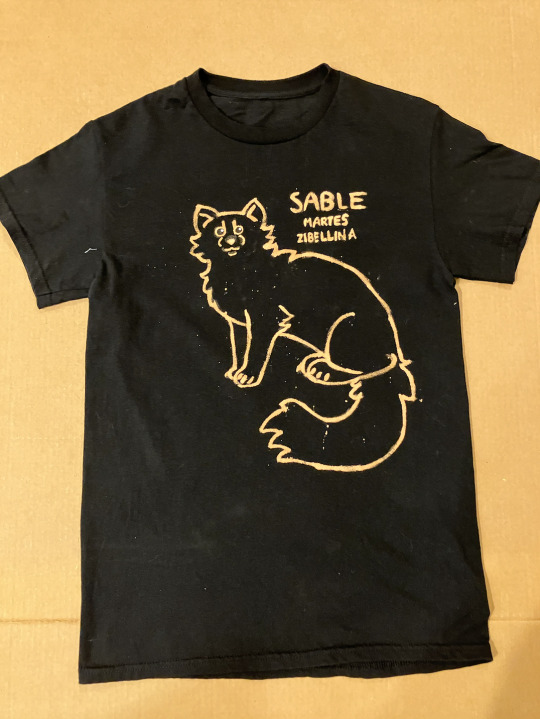
I see a lot of 'diy gear' around so I'm surprised I've hardly ever seen bleach dyed shirts! They're honestly one of the coolest, easiest, and relatively inexpensive ways to make discreet gear - especially if you're like me and you can't exactly find shirts of your theriotype being sold.
Tutorial under the cut!! :3
What you will need:
A black t-shirt, preferably 100% cotton (avoid polyester and spandex)
Bleach
Water
Sidewalk/blackboard chalk, or a chalk pen
A paintbrush to apply the bleach
A disposable cup
A bit of cardboard or plastic to put under the shirt (to prevent the design from bleeding through onto the other side)
GLOVES and other safety gear (ie, a mask and goggles)
fabric paint, not puffy paint (optional but if you're heavy handed like I am it helps so you can fix screw ups)
SAFETY:
Work in a well ventilated area.
Wear gloves, goggles, and ideally a filtration mask when handling bleach.
WASH YOUR HANDS thoroughly after handling the bleach and do not touch your eyes or face before washing your hands
Be mindful of chemical reactions that can occur when mixing bleach with other cleaning products - never, ever, EVER mix bleach with anything containing ammonia as it can react and create toxic chlorine gas.
Keep bleach out of the reach of pets and small children, and if you have small animals like birds or rodents, work AWAY from them as the fumes can damage their lungs.
Make sure you read the back of your bleach container so you know how to handle and dispose of it safely.
Process:
Slide the cardboard into the shirt, adjusting it so you'll be drawing on the side you want your design on.
Use the chalk to draw your design on the fabric - don't worry about screwing up here, it'll wash out later. (If you want to, you can digitally draw your design, print it out, then trace the back with chalk and press it onto the shirt to transfer the art)
Put on your safety gear (ESPECIALLY your gloves) and move to a ventilated area (I did this on my back porch)
Carefully pour some bleach into your cup, then cut it with water. Remember that the more water you add, the more of the solution you'll need to apply to get your design to show up.
Apply the solution over your sketch using your paintbrush. You might need to apply it multiple times if your bleach solution is less concentrated.
Once your satisfied with your design, let it sit for 20 minutes to allow the bleach to fully stain the fabric.
After 20 minutes, rinse out the fabric under cool water. Make sure you're wearing your gloves as you do this so you don't hurt your skin.
Wash your shirt in your washing machine by itself, otherwise the bleach might transfer to other laundry. Put it in the dryer after or hang it up to air dry.
Clean up your area, wash your paintbrush out thoroughly, throw the cup away, and then remove your gloves to scrub your hands with soap and water.
Once your shirt is clean and dry, you can use fabric paint to touch up any mistakes. I used black paint to remove excess lines and white to give my design eye shines. Follow the directions for fabric paint on the back of the bottle, as the instructions for washing it can be different. Don't use puffy paint, the touch ups will end up raised and it'll look funny.
And there you have it! :D DIY gear shirt for all your alterhuman needs >:)
#therian#therian gear#alterhuman gear#otherkin gear#textile art#bleach dye#otherkin#alterhuman#therian gear tutorial#otherkin gear tutorial#bleach tshirt#alterhuman gear tutorial
30 notes
·
View notes
Text
Sign the petition to demand the creation of a new international law requiring fast-fashion garments to come with a statement of the human cost and environmental harm caused by their creation.
We all know fast fashion is bad for the planet - slave labor, environmental waste, air and water pollution, and unsustainable practices are just a few of the ways they impact our planet, our health and our lives. To date, the fast fashion industry is the 2nd largest consumer of water and is single-handedly responsible for 10% of global carbon emissions (that's more than all international flights and maritime shipping across a year combined). Even the simple act of washing these clothes releases 500,000 tons of microfibers into the ocean each year - that's equal to 50,000 plastic bottles. Fast-fashion is the 3rd leading cause of the climate crises we face, yet is rarely addressed.
Knowing these stats is one thing, and understanding them is important. Being aware of them is somewhat informative. But as long as we keep turning a blind eye to the issue, the stats are only going to get worse, and nothing will change for the better. Ignoring the issue or brushing it under the rug won't help anything. So what if we could see the real-world damage done by each of the garments we buy?
In the same way that cigarette packets have shown the harm their products do to our bodies ("SMOKING KILLS", lung cancer visualizations, etc.), what if fast fashion manufacturers & retailers had to show the harm their products do to our planet?
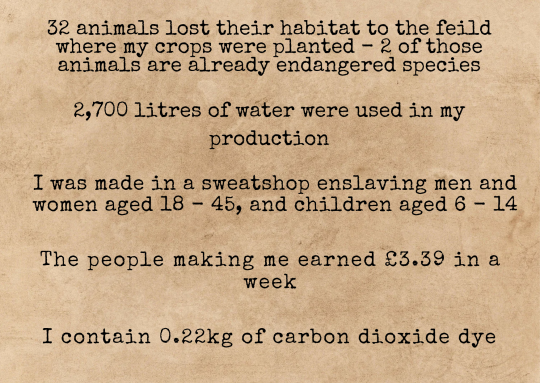
[Image ID: A type-writer font has been used on a brown craft paper background. The text reads: "32 animals lost their habitat to the field where my crops were planted - 2 of those animals are already endangered species. 2,700 litres of water were used in my production. I was made in a sweatshop enslaving men and women aged 16 - 45, and children aged 6 - 14. I contain 0.22kg of carbon dioxide dye." End ID.]
This is a mock-up of a label / statement for a single T-shirt, with researched statistics and educated estimates for the information I couldn't find a calculated answer for.
Now imagine labels / statements like this for every single piece of clothing: how many toxic chemicals are in those new jeans? How many litres of water did that shirt take to make? How many animals were skinned to make those cute fur-trimmed boots? How many children made that jumper? How many people were forcibly removed from their homes, so production companies could plant crops to grow the materials used in clothes manufacturing? How many families were evicted for no reason other than corporate greed? How many trees were cut down? How many animals were displaced or killed?
Would you really want to buy those items of clothing if the answers to those questions were staring you in the face?
If this information was stated in clear, accessible ways on both the website and the ticket on the actual garment, this would dramatically reduce the number of people buying fast fashion items. It would also reduce the profits being made by fast fashion companies, and could lead to many of them being forced to choose between changing and becoming sustainable, eco-froendly and ethical brands, or shutting down due to being boycotted.
Who would really want to knowingly buy things that are made by slaves, or which cost a family their home, or which contributed to deforestation? Who would continue to buy fast fashion items knowing this is the damage caused by them, when sustainable alternatives are an option?
Whether it's second-hand fashion at affordable prices, or investing more money in sustainable products which were made with high ethical standards and which cost more money due to the fact their price accounts for the time it took a person to make that item... we can say for certain that sustainable shopping is going to become much more popular if people know how important that change is. Sustainable items last much longer than fast-fashion items, which by design are created to self-destruct, as they are made to be worn a few times and then discarded in order to be replaced by the next trend's items - and as trends speed up, these items become weaker and weaker. This then leads to people spending more money in order to keep up with the newest trends, and to keep replacing clothes they throw out after a few washes.
In contrast, buying sustainable items which are designed to last years means people won't have to spend money on new clothes every few weeks, which means they'll ultimately save money in the long term and actually be able to afford those pricier items which will last much, much longer.
Now, despite the amount of harm the fast-fashion industry causes to people and the environment, the last thing we should be doing is getting angry at those who continue to buy them. Being the target of anger doesn't make large populations change their behaviour - even a cursory look through history books will tell us that much. Neither does being the target of resentment or blame.
But guilt? Shame? Those are two of the most powerful emotions to magnify when you want change to happen in waves.
And frankly, if people feel ashamed of buying something, or if buying something makes them feel guilty... they're going to stop buying it.
Those aren't the only emotions that should be felt, though. Because only feeling guilt and shame leads to feeling hopeless, scared, anxious and depressed. And we don't want that. No matter how bad things get... we don't want that.
The only other emotions to provoke are hope and pride.
If there's no hope for the future, how can anyone be expected to imagine a better one?
You wouldn't think it, what with all the climate crises and disasters we experience around the world and the total lack of commitment made by billionaires, multimillion-dollar companies and corporations and politicians.
But it's true. Scientists in Scotland have discovered bacteria which eat plastic and speed up the decomposition of it. ‘Ecocide’ is now punishable by law. Some countries within the EU are already close to meeting their 2030 goals years ahead of schedule! Thanks to scientists and small, individual changes made on a massive scale by ordinary people who are making small adjustments to our everyday choices, we can and are healing most of the ozone layer before 2050. That is something we should all feel incredibly proud of.
So imagine how much we could speed that process up if more people made those changes. Imagine how much sooner we could heal our planet if billions of people made those changes, rather than millions. Imagine how much sooner we could be seeing the effects of a healthier planet if fast fashion companies were forced to choose between going green and transparent, or closing altogether due to a lack of interest from consumers. Imagine the changes we could create if corporations made massive changes in a short amount of time, in order to save their own profits.
Imagine more labels like this, sitting alongside each other on every single piece of fast fashion clothing. A statement like this beneath every item of clothing on fast fashion websites, which transparently states the harm done.
If every single fast-fashion company and store had to display this on their clothing, on their racks, on their websites, and if there were legal punishments for those who tried to evade or lie... fashion would turn a lot greener very quickly. We'd start seeing more and more labels with "I'm made from 6 plastic bottles! I used to be a newspaper! I had 0 pesticides used on me in my production! I only contain natural dye made from berries, beans and sustainably grown flowers. I was made from apple skins and corn! The people who made me get to go home to their families every night, have days off and the adults made £150.35 each in 1 week! The animal who made the wool for me is free-range and well-cared for! I came from a small family farm, and was created with a closed-loop water system!”
That'd be a much better civilisation to shop in, don't you agree?
That is hope for the future.
That is motivation, which can fuel ordinary people to do extraordinary things and create changes they thought were impossible.
If you want to be a part of creating this change, sign the Change.org petition which demands the the creation and implementation of an international law which will require all fast-fashion products to be displayed with a statement which states the harm done to people and the planet by that garment being made & shipped.
#fast fashion#fashion#climate crisis#climate change#climate action#climate catastrophe#environmentalism#environment#environmetalists#enviromental#sustainability#sustainable#economy#ecofriendly#ecosystem#europe#earth#ecommerce#society#socialist#sociology#social justice#social media#slave labor#children#child labor#children's rights#environmental justice#petition#petitions
35 notes
·
View notes
Text
HISTORIC ACCOUNTS OF CHESAPEAKE BAY FISHERIES
Early colonists early in North American history once "stood staring in disbelief at the quantities of fish." One man wrote "there was as great a supply of herring as there is water. In a word, it is unbelievable, indeed, indescribable, as also incomprehensible, what quantity is found there. One must behold oneself."
They wrote of hauls which netted 5,000 fish, each fish over two feet in length - prodigious spawning runs of shad, rockfish, and herring, oyster reefs which stuck out above water at low tide, and sturgeon so plentiful that they frequently jumped into their boats.
--
"Sturgeon and shad are in such prodigious numbers that one day within the space of two miles only, some gentlemen in canoes caught above six hundred of the former with hooks, which they let down to the bottom and drew up at a venture when they perceived them to rub against a fish; and of the latter above five thousand have been caught at one single haul of a seine."
-English traveler Andrew Burnaby, 1759
In the spring of the year, herrings come up in such abundance into their brooks and fords to spawn that it is almost impossible to ride through without treading on them. -Historian Robert Beverly, 1705
The abundance of oysters is incredible. There are whole banks of them so that the ships must avoid them. -Swiss explorer Francis Louis Michel, 1701
--
Today, 84% of the Chesapeake Bay’s tidal waters are considered partially or fully impaired by chemical contaminants. The most common metal found in the watershed is mercury.
Today, Sturgeons are on the brink of extinction.
Over-harvesting, disease, pollution and habitat loss have led to a severe drop in oyster populations in the Chesapeake bay. The oyster population is estimated to be less than 1% of what it once was.
In 1980, Maryland closed its commercial shad fishery, to help conserve Shad populations.
Overfishing devastated the Chesapeake's rockfish stocks in the 1970s, but intensive conservation efforts in the 1980s through the 2000s restored them to sustainable levels. However, recent assessments of rockfish indicate the stocks are once again on a downward trajectory, with indications that overfishing is occurring and the stocks are in a depleted state.
In April 2020 EPA reversed its stance on regulating toxic chemical emissions, including mercury, from power plants.
Over four years, the 2017-2021 Trump administration dismantled more than 100 environmental rules, which weakened previous limits on planet-warming carbon dioxide emissions from power plants and vehicles; removed protections from more than half the nation’s wetlands; and withdrew the legal justification for restricting mercury emissions from power plants.
14 notes
·
View notes
Text
A bit about "oil of vitriol"
In the last letter that I received from my friend Watson I was waiting for a girls fight but Kitty Winter surprised everybody with a chemical attack using "vitrol" against the villainous Baron Adelbert Gruner.
Oil of vitrol is an outdated name of sulfuric acid (H2SO4), a colorless oily liquid widely used in industrial processes. This name comes from "vitrols", sulfates of different metals like copper, iron or aluminium. My favourite one is copper(II) sulfate penahydrated CuSO4·5H2O because is blue:

[ID: blue crystal of copper(II) sulfate]
Sulfuric acid has been known for many centuries, but medieval European alchemists called it "oil of vitrol" because they prepared this oily sustance by roasting iron(II) sulfate FeSO4·7H2O or green vitriol in an iron retort.
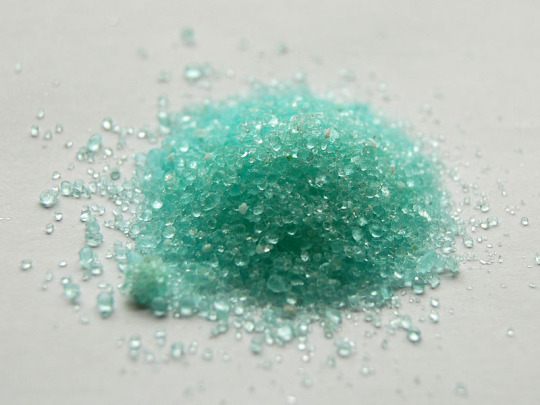
[ID: green crystals of iron(II) sulfate heptahydrate]
There are many ways to produce sulfuric acid but in 1831 British vinegar merchant Peregrine Phillips patented the contact process. This method is economical for production of sulfuric acid in high concentrations and still in use today.
It surprised me how cold blood acted Kitty Winter carrying the oil of vitriol considering this hazards:
- CORROSIVE and/or TOXIC; inhalation, ingestion or contact (skin, eyes) with vapors, dusts or substance may cause severe injury, burns or death.
- Fire will produce irritating, corrosive and/or toxic gases.
- Reaction with water may generate much heat that will increase the concentration of fumes in the air.
- Contact with molten substance may cause severe burns to skin and eyes.
- Runoff from fire control or dilution water may cause environmental contamination.
But during those years there wasn't many norms related to use, transport and labelling of chemicals like today, even the treatment of chemical burns is different. Dr. Watson used water to dilute the acid, then applied oil and cotton to protect the wounds. Currently he standard first aid treatment for acid spills on the skin is irrigation with large quantities of water. Washing is continued for at least ten to fifteen minutes to cool the tissue surrounding the acid burn and to prevent secondary damage. Contaminated clothes should be removed to wash the skin underneath. Additional measures like diluted solutions of sodium bicarbonate can be used for smaller burns but in case like Gruner is better to use the shower 🚿
#letters from watson#science#chemistry#the illustrious client#ILLU#acd canon#medicine#letters in the underground
50 notes
·
View notes
Text
The Human Body
It comprises living cells and extracellular materials, organized into tissues, organs, and systems.
It is primarily composed of water and organic compounds, lipids, proteins, carbohydrates, and nucleic acids.
Water, making up about 60% (varies by age) of body weight, is crucial for life's chemical processes, found in both extracellular fluids and within cells, serving as a vital solvent.
The skin and related structures form the integumentary system, safeguarding the body from harmful invaders and chemicals while also preventing water loss.
Comprising skeletal muscles and bones (about 206 in adults), the musculoskeletal system facilitates body movement and shields internal organs.
Incorporating breathing passages, lungs, and respiratory muscles, the respiratory system acquires vital oxygen from the air for cellular metabolism and expels waste carbon dioxide.
The circulatory system, comprising the heart, blood, and vessels, circulates fluid throughout the body, furnishing cells with oxygen and nutrients while removing waste like carbon dioxide and toxic compounds.
The digestive system comprises the mouth, esophagus, stomach, and intestines, breaks down food into usable nutrients, absorbing them into the bloodstream, and eliminates the remaining waste as feces.
Consisting of kidneys, ureters, bladder, and urethra, the excretory system filters toxins and waste from the blood for elimination.
The nervous system formed by sensory organs, brain, spinal cord, and nerves transmits sensory data, integrates it, and triggers appropriate muscular or glandular responses.
Composed of hormone-secreting glands and tissues, the endocrine system coordinates body processes via a chemical communication network.
The reproductive system, encompassing male or female sex organs, plays a crucial role in facilitating reproduction.
In males, this system includes structures such as the testes, which produce sperm, and in females, it comprises the ovaries, which produce eggs.
📹 (✏️) : SciePro
#human body#water#skin#musculoskeletal system#respiratory system#circulatory system#digestive system#excretory system#nervous system#endocrine system#reproductive system#integumentary system#science
21 notes
·
View notes
Text


🇮🇱⚔️🇵🇸 🪖👪 ⛺ 🚨
ISRAELI OCCUPATION USING GAZA VIOLENCE TO ACCELERATE FORCED REMOVAL OF PALESTINIANS FROM OCCUPIED WEST BANK TERRITORIES
One of the most tragic crimes being overshadowed by the war in Gaza has been the acceleration in the forced removal of Palestinians from villages and towns in the occupied West Bank territories.
As Israel's war of genocide continues unabated in the Gaza Strip, daily raids in the occupied West Bank have resulted in the deaths of at least 390 civilians, including 102 children, and wounded in excess of 4'450 Palestinians.
But while the raids and bombings capture headlines and negotiations between embassies, a quieter action taken by the Israeli occupation has been the forced transfer of more than a thousand Palestinians from towns and villages in the West Bank.
According to the Israeli Human Rights organization B'tselem, 151 Palestinian families numbering 1'009 people, including 371 children, have been forcibly displaced by a vicious combination of heavy-handed Israeli occupation soldiers threatening and removing families and violent attacks by colonial settlers.
B'tselem says the process began long before the start of the war in Gaza, but has accelerated "under the cover" of the war.
The human rights organization has decumented each and every case, and while we cannot include every miticulously recorded story from B'tselem, we will share one or two and leave the reader to choose whether to access the source or just imagine scaling up the following stories a thousandfold.
In the village of Khirbet ‘Ein a-Rashash, in the central mountain range, on October 9th, 2023, several colonial Israeli settlers blocked the main road leading into the community, which the Israeli Occupation Forces (IOF) had repeatedly blocked in the past, with local residents reopening the road into the village themselves.
This time, the settlers blocked local water tankers from accessing the village, the sole source of potable water for the community. Many Palestinian territories do not have access to clean water due to Israeli agricultural chemical and toxic runoff which is filtered into Palestinian territories, destroying local water sources.
With their sole source of clean water blocked off from accessing the village, the local farmers moved 1'500 heads of sheep to the village of Duma. Soon after, the women and children of the community followed, leaving for Duma to access clean water and other daily supplies Westerners take for granted but are regularly blocked off from Palestinian communities.
On October 16th, 2023, the men left Khirbet ‘Ein a-Rashash to join the women in Duma. Even without the violence that characterizes the Israeli occupation, the settlers had succeeded in eliminating an entire village of Palestinians in just a few days.
In another example, in the Palestinian West Bank village of Wadi a-Siq, on the central mountain ridge, escelating threats by Israeli colonial settlers led local Palestinian families with young children to begin leaving on the evening of October 10th, 2023.
One by one, 30 Palestinian families, numbering 180 civilians, including 40 children, left Wadi a-Siq as the threats continued to roll in. They'd watched as the slaughter in Gaza accelerated into a genocide and decided not to risk their own families on the outskirts of the occupied West Bank, despite calling it home for generations.
On the 12th of October, while Israeli activists and the few remaining men in the village were taking down the structures and grabbing what they could save, loading them onto trucks, a group of Israeli settlers, backed by IOF soldiers, arrived and began beating and brutally attacking them. No Palestinians have been able to return since.
On October 10th, 2023, in the village of Atiriyah, south of a-Samu', in the southern Hebron Hills, two Palestinian families, numbering 31 citizens, including 20 children, were attacked by an armed Israeli settler who opened gunfire at a flock of sheep, killing three.
Soon after this event, on the night of October 14th, 2023, a large group of Israeli settlers arrived in Atiriyah and threatened harm to the families if they did not leave the community in 24-hours. On the night of October 23rd, with violence escalating in all the Palestinian territories, the families left, and have not returned.
In the Palestinian village of Khirbet Zanutah, in the southern Hebron Hills, a community of 27 families, numbering a total of 250 people, including some 100 children, was facing escalating threats and harassment from armed Israeli colonial settlers, sometimes accompanied by the Israeli Occupation Forces, who repeatedly ordered the community to vacate the premises. Armed settlers and soldiers riding ATVs kept arriving, threatening families with violence unless they leave.
On the evening of October 12th, 2023, with the violence in the West Bank quickly accelerating just after Hamas's attack on October 7th, several armed Israeli settlers arrived in two vehicles to three Palestinian homes and proceeded to beat the residents, hitting them with firearms, smashing solar panels, threatening families and destroying a car door before leaving again.
On the night October 23rd, the violence escalated again when two Israeli settlers arrived at the Samamrah family home, shoving the mother of the family, Hanaa Abu al-Kabash. The settlers then purposefully drained two water tanks local families depend upon to survive before leaving again.
On October 24th, 2023, settlers arrived once again. Escalating the violence further, they began throwing rocks at local residents, smashing solar panels, draining the few remaining water tanks, and smashing the windows of one home.
On October 27th, a group of local residents were sitting outside their home when four Israeli colonial settlers arrived in a civilian vehicle and proceeded to attack local residents with stones and threatening them after the residents began recording the incident. At one point, an Israeli settler threw a stun grenade at the Palestinian residents. The residents were forced to flee inside their homes.
Unfortunately, the damage had been done and the local families, terrified of the escalating threats and their accompanying violence, decided the leave. Soon after, a group of Israeli human rights activists arrived with foreign journalists to find that 10 local structures had been destroyed, including residential homes, agricultural buildings and even a school.
B'tselem is filled with stories like these recorded since October 7th, however the process has been ongoing for 70 years, beginning with the 1948 Nakba and only accelerating as the Gaza War overshadows the events in the West Bank occupied territories.
In addition to the communities that have been forcibly displaced, some communities have not completely given in to Israeli settler and soldier threats, where some families remain or just men remain while parts of the communities have left. More than 11 families totaling 89 Palestinians, including 32 children have been displaced from communities that have not been completely abandoned as of yet.
As Israel's genocidal war in Gaza rages on, and an invasion of Rafah City is immenent, the West Bank territories continue to be torn apart, limb by limb, until only a handful of disconnected communities spread across the territories and separated by Israeli Occupation checkpoints remain, and the international community continues to do nothing.
#source
@WorkerSolidarityNews
#west bank#occupied west bank#occupied territories#occupied palestine#b'tselem#occupation#israeli occupation#israel#palestine#palestinians#palestine news#gaza war#israeli war crimes#war crimes#crimes against humanity#israeli crimes#israeli occupation forces#ethnic cleansing#war#middle east#israel palestine conflict#politics#news#geopolitics#world news#global news#international news#breaking news#current events#israeli apartheid
32 notes
·
View notes
Text

E-Waste Recycling
Recycling of e-waste is complicated due to the many different components and materials that can be found in a single product. Recycling typically proceeds through the following steps: manual sorting, examination for reusable components, disassembling, shredding, and then separation. Ferromagnetic materials/metals can be separated through the use of large magnets, followed by eddy current separation to extract the paramagnetic materials/metals. The remaining non-magnetic materials are often separated by submerging in water and separating out by density (glass, which doesn't float; plastic which does).
Statistics from 2019 indicate that less than 20% of e-waste was recycled globally. This is not helped by the complications that can arise during disassembling, such as with cell phones whose batteries are no longer designed to be removed and the risks of exposing workers to toxic chemicals. Difficulties also arise in recycling metals through mechanical means, as is typically done. Less than 20% of the elements found in electronics are estimated to be capable of recycling through mechanical means.
Sources/Further Reading: (Image source - EPA) (Earth.org) (EcoWatch) (2016 article) (Wikipedia)
13 notes
·
View notes
Text
Saturday August 24, 2024
Karen Bracken
As I am sure you all know by now….RFK Jr. has given his support to Donald Trump. He offered his help to Harris and she refused to even talk with him. Trump and Kennedy agree on ending all wars and to help end the chronic diseases killing our children and adults. He could only be an asset to helping heal our country. I watched his entire press conference and he is a brave man and speaks truth. He also knows where the bodies are hidden. He is hoping that the Trump administration will love our children more than we hate each other. Here is a link to his press conference. VIDEO
TRUTH IN HUMOR - Don’t miss this short satire. VIDEO
Did the US Government Pay $370,000 Death Benefit for a Covid Vaccine? ARTICLE
How Kamala Harris's friendship with Beau Biden united her with Joe - hmmmm perhaps she had more than Beau’s back??? She stated in this article that she was bussed to school everyday. “There was a little girl in California who was part of the second class to integrate her public schools, and she was bussed to school every day. And that little girl was me,” Harris said. Kamala left the US when she was 7 years old and lived in Canada until she graduated from High School. Just another lie about her past. She is NOT A NBC and I will say this every time I share anything about her until Americans start demanding Harris/Walz be removed from the ticket. Another lie…….she surely didn’t take her “friendship” into account when she viciously attacked Joe Biden during the 2020 election period - Biden picked her because he was ordered to do so by her mentor and Biden’s puppet master Barack Obama - ARTICLE
Door To Freedom (Dr. Meryl Nass) and Children’s Health Defense host a 2-day live stream conference on: Attack on Food and Farmers and How to Fight Back - INFORMATION
Sun Drives Earth's Climate, Not CO2: 30-Page Study in Journal 'Geomatics' Refutes Mainstream Climate Change Narrative - When they came up with UN Agenda 21 (global communism) they knew no one would ever go along with this plan of global governance under communism. SO they invented a global boogie man. They has to come up with something that affects the entire world. First it was global warming and when they exposed that as the lie it was they changed it to climate change. Climate change IS just the new name for UN Agenda 21. So is Sustainable Development, Smart Cities, 2030 Agenda, Sustainable Development Goals, Great Reset all one in the same. A very good friend of mine was a NASA research scientist. He was invited to present to Congress every year (until Obama was elected...he was uninvited but sent his research to every member of Congress each year). He warned of global cooling and its impact on food. He said the sun goes into hibernation approx. every 235 years and it was moving into a period of hibernation. CO2 is the foundation for life. The more CO2 the better. Food grows with CO2 so it is clear to me why they targeted man made CO2 as their target. My friend, John L. Casey wrote a book called COLD SUN........he like many REAL scientists know the sun controls the climate except for the climate our government creates in order to scare people into compliance. I recommend getting John's book. He had a stroke some years back and no longer is doing research. He also used to track earthquake activity too. ARTICLE
CDC Stands by Water Fluoridation After Report Linking Fluoride to Lower IQs in Kids Finally Published - Good old CDC strikes again. Gee remember when tooth decay was killing people? Dead people all over the place. No? Well neither do I because no one has ever died from tooth decay BUT lots of animals and trees were dying when chemical companies were spewing their toxic waste into the air so they came up with a brilliant idea…..we will put it in the water supply and convince people it was harmless and would stop tooth decay. Now if that were true there would be a lot less dentist today, right?? And what about countries outside of the US. Are there people dying in the streets of tooth decay? No. And they do not have any more incidence of tooth decay than we do here in the US. This deal was a deal to help out companies dispose of their toxic waste at our expense. Did you notice they now sell fluoride free bottles of water for baby formula?? Why? If it is so safe why are they selling fluoride free baby formula water? It is not safe. They lie to us all the time and we believe putting a toxin in our water is safe? There are about 13 countries just in Europe that do not put fluoride in their water and they do not have any higher incidence of cavities than we do here in the US. Good daily dental care is a much wiser prevention for cavities. Putting fluoride in our water was just another lie in order to save chemical plants a lot of money disposing of the toxic waste. ARTICLE
8 notes
·
View notes
Text
Listen! You know I am a big Natsuhiko simp. It was normal for me to wonder about his necklace.
I think his necklace is REALLY important. What we know about Natsuhiko's necklace? It is a present from Sakura and it is germanium. He is just so casually says it in here.

I needed to check what is germanium and
1) Why did Sakura gave Natsu a germanium necklace?
Let's start with germanium itself. If I pass the more scientific stuff about germanium, this is what I get so far:
• It is a metalloid in the carbon group that is chemically similar to its group neighbors silicon and tin.
• Germanium is not thought to be an essential element for any living organism. Similar to silicon and aluminium, naturally-occurring germanium compounds tend to be insoluble in water and thus have little oral toxicity. However, synthetic soluble germanium salts are nephrotoxic, and synthetic chemically reactive germanium compounds with halogens and hydrogen are irritants and toxins.
•The major end uses for germanium in 2007, worldwide, were estimated to be: 35% for fiber-optics, 30% infrared optics, 15% polymerization catalysts, and 15% electronics and solar electric applications. The remaining 5% went into such uses as phosphors, metallurgy, and chemotherapy.
•Germanium supplements, made from both organic and inorganic germanium, have been marketed as an alternative medicine capable of treating leukemia and lung cancer. There is, however, no medical evidence of benefit; some evidence suggests that such supplements are actively harmful.
So. We use germanium more in technology and it is not usually harmfull for people. Wanna know what I decided to search? Germanium necklaces. Just to see if it has any meaning.
I checked the first web-site and I know, I should've search more but I was curious. I searched "germanium necklace benefits" and wanna know what I found out? Apparently, germanium jewelry;
• Increases blood circulation
• Increases metabolism of body cells
• Removes harmful toxins
•Alleviates physical stress, stiffness, cramps or discomfort
• Controls swelling
• Reduces water retention
• Relieves fatigue and tiredness
• Promotes quality sleep
• Slows down aging
• Increases and maintains body warmth
But Cesear, why are they important??
It's because, I am almost sure that Natsuhiko is not wearing his necklace in this panel.

He is not wearing it. He can't. That necklace looks more like a collar than a necklace. For exemple, look here:

And here, now look at his germanium necklace:

That thing is not loose. I don't think he can wear that thing under a shirt that buttoned all the way up and a necktie. Look again. Do you see what I mean?

And in these panels, it is the first time Natsu talks about something that hurts him. He experienced some wild things before with Nene.

He looks scared but totally ok in here.

He looks scared, not in pain.

And he just comes back like nothing happened. These panels was one of the reasons why I thought he was immortal in the first place. He is wearing his necklace in all of them. He looks fine, he looks like his usual self. But in the raws, he looks tired. My friend pointed it out for me that in whole manga, this is the only time Natsu look genuinly tired and also, he mentions himself as a "human."

Maybe it's because he is losing blood but I don't think that much of blood and that much of a time is long enough for him to feel tired. I think he is not wearing his necklace and that necklace is healing him.
But Cesear, what does the necklace healing Natsu from?
Good question.
Before these raws, I thought that Natsu was sick and he was dying. Remember where people use germanium? Don't bother scroll back up, I'll show you again.
• Germanium supplements, made from both organic and inorganic germanium, have been marketed as an alternative medicine capable of treating leukemia and lung cancer.
But now that we have the raws, I know what the necklace heal Natsu from.
I think it is healing him from his own blood.

We now know that Natsuhiko is immortal (like I was saying for months now) because of a rumour that Sakura released but Natsu is not entirely supernatural. His blood causes the supernatural things to break down, it is toxic for them.
And if Natsu is at least somewhat immortal, that means that his blood might be toxic for him as well. He is also immortal. Which might put Natsu in a circle; his own blood keep hurting and killing him inside while his immortality forces him to live. It must be painful, he feels pain. He says that either cutting his palm or his blood hurts so he feels it. He can't be useful like that. So, how are we going to fix it?
By giving him a healing necklace which is also believed that helps with aging process.
So. Now you know why I found that necklace really important.
#toilet bound hanako kun#hyuuga natsuhiko#headcanon#i think it is really important#that necklace must mean something#it can't be just a random necklace#no fucking way
59 notes
·
View notes
Text
Let's Talk Pyrite Disease
Okay. Pyrite is amazing. Pyrite, or fool’s gold, has a simple formula (FeS2), forms beautiful cubes, and has all sorts of cool features. I'll talk later about how iron minerals can move and change and how they're related to theories about cells, but first, let's talk about Pyrite disease.

Image ID: Several pyritized ammonite shells in various stages of decay. They all have a light-grey color and a velvety appearance. There are a few in the center that are severely decayed and appear to be just a pile of dark grey and yellow dust, with a similar appearance to mold. One ammonite in the top-center is a more gold-brown color and has cube-shaped pyrite crystals on it. End ID.
[Image by https://twitter.com/MSidKelly/status/667548523475288064]
TLDR: Pyrite disease is a form of rust that impacts pyrite. It produces iron oxides, sulfuric acid, and sulfur dioxide, damaging mineral specimens, fossils, and storage materials. It causes expansion and acid damage that cracks and erodes specimens.
oh and @simple-potato-farmer, @team-clockers, @edthefatmagicturtle, y’all expressed interest in this so here you go! warning: it’s 10 pages long
How Can Fossil Come in Contact with Pyrite?
Pyrite is the most abundant sulfide mineral. Pyrite is found in quartz veins, coal mines, sedimentary rock, metamorphic rock, and in fossils as a replacement mineral. Pyrite forms in anoxic environments, which makes it a good environmental indicator. It also means that pyrite is found in association with many deep ocean fossils.
Fossils can be replaced by pyrite. This happens in a process called pyritization, a form of replacement diagenesis where the original material of the organism (in some cases, even soft parts) is replaced by pyrite. For instance, due to the anoxic and high-sulfide concentration in the deep ocean, calcite shells may be replaced by iron pyrite. This is aided by the presence of sulfur-reducing bacteria that facilitate the creation of iron sulfides, and therefore facilitate the precipitation of pyrite during decay(1) as sulfides are produced by the decaying organism(2). In a unique case, high microbial activity led to documentation of pyrite formation on the shells of living mollusks(3). This process leads to beautiful pyritized fossils that look like metal casts but actually are the fossil completely replaced by pyrite.

Image ID: An ammonite cut in half to show pyritization. The entire ammonite appears metallic gold, and the internal cavities contain fine drusy pyrite crystals. End ID.
[Image by: Replacement/Recrystallization (petrifiedwoodmuseum.org)]
Not all fossils end up beautifully pyritized, and not all pyritized fossils stay that way. Pyrite disease, also called pyrite oxidation, pyrite rot, or pyrite decay, is a form of rust. Millions of years of history, only to be destroyed by poor archiving, humidity, and pyrite decay.
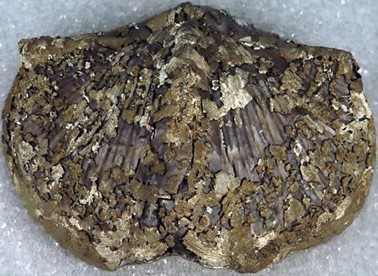
Image ID: A brachiopod specimen with pyrite replacement and a patchy outer coating of pyrite. Unlike the ammonite, the pyrite has grown over the shell of this brachiopod in addition to replacing the original structure. End ID.
[Image by: jsjgeology.net/Replacement.htm]
What does Pyrite Disease Do?
Since pyrite is formed in anoxic conditions, most pyritized specimens remain stable for a long time. The reason we observe so much pyrite decay in museum settings and other fossil collections is because the specimens have been removed from the rock and sediment that were limiting their exposure to oxygen. Pyrite decay can occur with or without water, but when pyrite oxidizes in humid air, it reacts with both oxygen and water. This creates not only iron oxide ‘rust’, but also iron sulfate, sulfuric acid, and sulfur dioxide gas4 (corrosive and toxic materials)(1). This chemical reaction eventually destroys the specimen through a combination of factors. The sulfuric acid is corrosive and damages the specimen. Oxidized pyrite is unstable and may crumble over time. There is also another damaging factor: the risks of pyrite replacement and iron sulfate production.
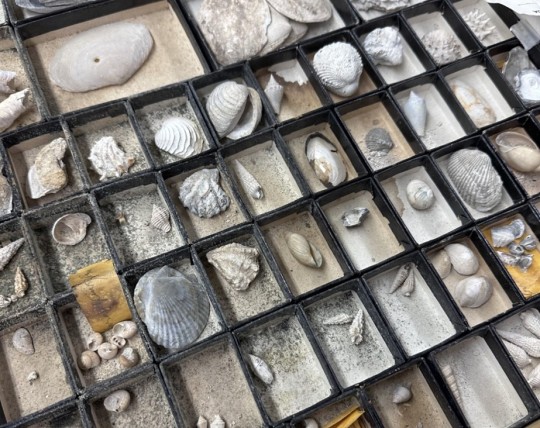
Image ID: A tray of mollusk fossils, each with separate boxes, with evidence of pyrite decay. There is dark grey dust in the bottom of most boxes, and a line of what appears to be water damage across the boxes. The apparent water damage is the result of the sulfuric acid produced. It has also discolored fossils and their labels. End ID. [Image by me]
Pyrite disease is a progressive process that affects fossils over time. Many pyritized specimens may last for years in perfect condition, while many others progressively decay from undetected pyrite disease. The reason that pyrite replacement is notorious for decay has to do with the crystal structure of pyrite. The famous cuboid structure of pyrite crystals is the most stable form of pyrite(4) since the compact form does not easily absorb moisture. Pyrite may occur in a compact, crystalline, stable form or a porous microcrystalline form that is unstable. Certain formations produce more stable pyrite with fewer impurities, but certain fossils are also more susceptible to unstable forms of pyrite. Marcasite is a less common dimorph of pyrite that is more unstable(5). Ammonites, especially those from the Charmoth clays, are notorious for pyrite decay while South American specimens and Yorkshire coast fossils are much more stable(2). The iron sulfate that is produced by the oxidation process is considered an efflorescent mineral(5), a term that means “flowering.” This is because this material has a higher molar volume (the ratio of the volume occupied by a certain amount of a substance) than iron pyrite and wedges the specimen apart as it expands past the constraints of the original crystal structure(5).
Unfortunately, the creation of efflorescent minerals, including other hydrous sulfate minerals, creates a feedback loop. These materials produce acids and provide water that causes the pyrite to further decay, producing more Fe3+ and more efflorescent materials, which feed the cycle of oxidation(5).

Image ID: Two images of the same pyrite disk, taken two years apart. In the left image, the disk has a few cracks and white discoloration in the center, with a yellow outline around the discoloration from sulfur. In the right image, the disk is shown two years later, cracked into four large pieces. The discoloration now extends almost to the edges of the disk, with a much larger yellow margin. End ID.
[Image by Ed Clopton, General: Need 'Pyrite Disease' Photos (mindat.org)]
(For an interesting, related topic – pyrite decay is a risk in coal mining for a multitude of reasons, including the increase of pulmonary and respiratory disease after pyrite inhalation, the risk of silicosis, and the risk of spontaneous combustion caused by the exothermic reaction involved in the decay of high-sulfide deposits.)
What Does Pyrite Disease Look Like?
Pyrite disease may appear grey, greenish, black, red-orange, white, or sulfur yellow. A redder color indicates rust from other iron minerals other than pyrite. Since pyrite contains sulfur and pyrite oxidation produces sulfuric acid, it may have the rotten-egg smell often associated with sulfur. A metallic-iron smell may also be present. Inhaling the result of pyrite decay can be hazardous (in my experience, it caused migraines even when I double-masked before entering the room due to the severity of the condition of our collections. In most cases it is much less of a concern). If pyrite disease is found, wear gloves and masks and try to disturb the dust as little as possible. Remember that pyrite disease is worse in humid conditions, and these same conditions may encourage the growth of mold. The early stages of pyrite disease may appear as spots of discoloration on a fossil, a slightly duller appearance, additional crystallization, or cracking. Often, the first noticeable sign that is clearly identifiable is dust in the bottom of the box the specimen is in. In these early stages, the severity of the pyrite decay may not be detected until the specimen is moved or handled, and subsequently begins to crumble or leaves dust and a metallic smell on your hands. Later stages appear like mold and may have a fuzzy, cloud-like appearance. If you handle a specimen with pyrite disease, take care to wash your hands and dry them well before handling any other specimens, and check the container or the contaminated specimens and those that surround it so that they can be replaced if needed. In the worst stages of pyrite decay, what is left is not a fossil that may crumble if handled, but a pile of dust. Pyrite disease can affect vertebrate fossils, invertebrate fossils, botanical specimens, mineral specimens with pyrite, and the containers and shelving used.
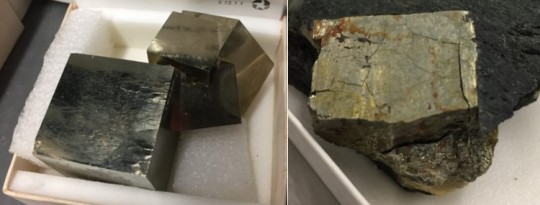
Image ID: Two images of cubic pyrite crystals. Left: Four cubic pyrite crystals growing into each other, they are a solid metallic gold color with few visible imperfections. Right: a cubic pyrite crystal in a dark matric. This piece is affected by pyrite decay, and the cubic shape is no longer perfect due to cracks in the specimen. It has orange and yellow sections that appear like water stains due to the sulfuric acid produced by pyrite oxidation. End ID.
[Image by Pyrite Disease - Canadian Museum of Nature]
Why Is It A “Disease?”
If the damage to the fossils themselves was not bad enough, consider another factor: it’s often called pyrite disease, instead of pyrite oxidation, for a reason. That reason is that pyrite disease spreads and progresses over time. Historically it was thought that this was the result of a bacterial component, and it was even recommended to treat fossils with antibacterial ointments(5). While bioleaching of pyrite is studied, bacterial theories are no longer supported. The spread of pyrite disease is due to the spreading of acid and the flaking of iron sulfates that may trigger decay on other specimens that already contain pyrite. Although this process is not contagious due to bacteria, it is still an irreversible process that causes fossils to crumble to dust and is, to an extent, a contagious process. The sulfuric acid and sulfur dioxide created in pyrite oxidation can damage the containers and fossils near the contaminated specimen.
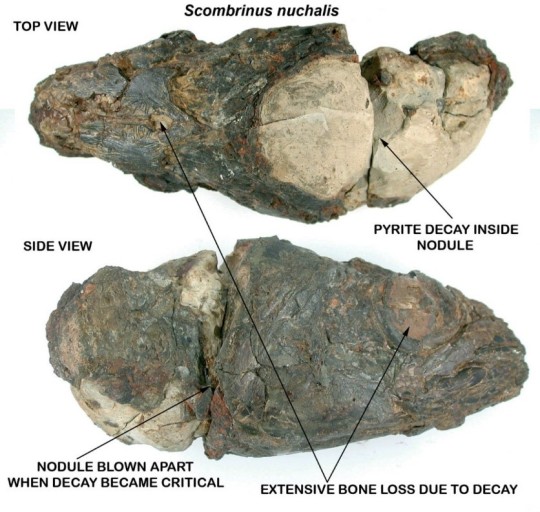
Image ID: An annotated example of a fish skull preserved in a nodule, which decayed and broke due to pyrite disease. There is a top view (top) and a side view (bottom, fish facing right). There are labels pointing to the top of the skull and to the eye socket showing cavities and red-orange rust labeled “extensive bone loss due to decay.” A white section of the nodule that is split and crumbled is labeled “pyrite decay inside nodule.” The side shows extensive decay to both the fossil and nodule, labeled “nodule blown apart when decay became critical.” End ID.
[Image by Trouble with pyrite – Deposits Mag]
One of the reasons that it is considered a disease is the progressive nature of pyrite decay, which visibly worsens over time. Another reason is the way that sulfuric acid seems to spread and contaminate even the container that the fossil is held in, leaving damage marks on the fossil and its labels. Another factor is the fact that the products of pyrite oxidation expand, appearing like mold or growths that further damage the fossil. The expansion of these oxidation products is one of the most damaging aspects of pyrite disease, as the instability in the crystal structure of the specimen causes cracking and flaking. This is because pyrite oxidation causes the conversion of iron pyrite (FeS2), an iron sulfide mineral that has a cubic crystal structure, to iron sulfate (FeSO4), which has an orthorhombic crystal structure. Not only does this cause the specimens to crack and crumble, but the cracking of the specimen causes flakes of pyrite to break off and spread. These flakes may land on other specimens, spreading the contamination of pyrite decay to other fossils that were previously stable. In many cases, museums must face difficult decisions to remove scientifically valuable specimens, or even portions of specimens, to prevent further spread of pyrite disease.

Image ID: Left: The crystal structure of iron pyrite. Right: The crystal structure of iron sulfate. End ID.
[Images by: mp-226: FeS2 (Cubic, Pa-3, 205) (materialsproject.org)]
How Can Pyrite Disease Be Managed?
Now, I’ve said that pyrite disease is unreversible. But can it be stopped from progressing once it contaminates a specimen? The simple answer is no. The more complicated answer follows:
Several factors that contribute to pyrite disease: temperature, humidity, oxygen levels, pH, exposure, crystal structure, and bacteria(3). Some factors, such as bacteria and pH, require specific conditions that are uncommon (Thiobacillus bacteria are present over 95% humidity(3) and pH is often affected by the decay process and the methods used to manage it). Other factors are closely linked (e.g., temperature and humidity).
Pyrite disease is most closely linked to humidity and high oxygen conditions. The best way to stop pyrite disease is prevention. Most museums use some form of climate control to preserve their specimens, but the issue here is that vertebrate fossils (bones) have a moderate recommended relative humidity level (~45-55%) in order to avoid cracking or warping6, while the recommended humidity level to prevent pyrite disease is 30%(7) (although below 50% is also stated by some sources(2,8)). In contrast, humidity above 60% is known to accelerate the decay, even to the point that decay begins within a few days of exposure(3, 2). This low humidity level is not always possible, especially for public display, although it is used in some invertebrate collections. Using humidity and oxygen scavengers (e.g., silica gel packets) when collecting can reduce the exposure of specimens to these factors. Using humidity and oxygen barriers when storing specimens can prevent pyrite disease(3). Contained storage of an already contaminated specimen may trap moisture with the specimen. Although, I would say it is better to have an isolated specimen that decayed than have an open specimen contaminate others.

Image ID: The unpolished appearance of a pyritized ammonite. The ammonite is held in front of a rocky area. It is a dull grey color with a matte appearance. It has lumps of rounded pyrite surrounding it. End ID.
[Image by Martin Curtis, Pyrite Decay in Fossil Collections – ZOIC PalaeoTech Limited (zoicpaleotech.com)]
Since the damage from pyrite disease is exacerbated by sulfuric acid, one of the other prevention methods used relies on acid neutralization(5), although this is less common. Currently, the use of humidity and oxygen buffers is the most common method, but some groups rely on extensive testing of specimens to determine which have unstable forms of pyrite incorporated into the fossil or matrix before acting. Another preventative method is removing salt (which may speed up the decomposition) and removing any matrix that may contain pyrite or trap moisture (e.g., clays)(5). Washing specimens to remove salts or matrix remains could damage specimens that are already unstable or could cause damaging moisture exposure (although this could be avoided by washing with alcohol).
Many studies have attempted to find effective ways to stop, reverse, or prevent pyrite decay. From acid treatments to preemptively coating specimens in resin, these tested methods were often damaging to the specimens, especially over the long term. However, were they damaging enough to be worse than pyrite disease? Not necessarily, but a combination of the damage done, the cost, the time investment, and the ineffectiveness of these treatments means that prevention is still the only reliable method for pyrite disease.
Coating specimens in resins and varnishes may provide a buffering effect, but the resin only slows oxidation, it does not stop it. This becomes an issue when the vanishes cannot be removed, and the specimen cannot be accessed for other treatment methods(2). Varnishes may delay the effects, but they have effects of their own, are usually not moisture-proof, and may yellow and crack over time. Coating with resin or embedding the fossil in resin creates the risk of an explosion as the oxidative reaction builds heat and pressure. Some museums coat their fossils in plastic glues (such as Paraloid B-67 or B-72), these glues are reversible, and B-67 is hydrophobic, unlike most resins.
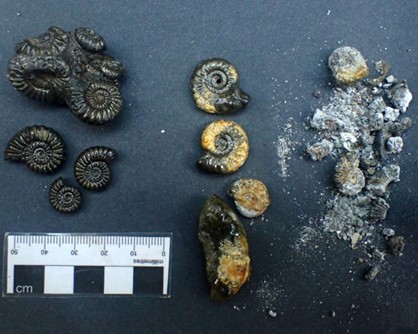
Image ID: Examples of varnished ammonite specimens, showing progressive stages of pyrite disease as the varnish aged and cracked. Left: Complete pyritized specimens with no signs of decay and a glossy finish from the varnish. Center: Pryitized specimens with patches of yellow-orange decay in sections where the varnish cracked. Right: specimens reduced to dark grey and white dust. End ID.
[Image by Chris Andrew, Pyrite Decay in Fossil Collections – ZOIC PalaeoTech Limited (zoicpaleotech.com)]
There are two ��cures” to pyrite decay. However, these do not cure pyrite decay in the sense that they reverse it. Instead, these are methods to neutralize the products of pyrite disease to prevent further harm to the specimens. These two methods involve the use of ammonium gas or ethanolamine thioglycolate to remove pyrite byproducts (ammonia converts the iron sulfate to iron oxide(8)) and neutralize any generated sulfuric acid(2). Both methods are intensive, potentially hazardous, and relatively expensive. As a ‘cure,’ they are effective at temporarily halting the progression of pyrite disease, but not preventing it or reversing it. These treatments have been proven to be ineffective at preventing pyrite decay without the use of controlled microclimate (oxygen and humidity exposure)(3).
References:
1 Replacement/Recrystallization (petrifiedwoodmuseum.org)
2 Pyrite Decay in Fossil Collections – ZOIC PalaeoTech Limited (zoicpaleotech.com)
3Minerals | Free Full-Text | Pyrite Decay of Large Fossils: The Case Study of the Hall of Palms in Padova, Italy (mdpi.com)
4Pyrite Disease - Canadian Museum of Nature
5Pyrite disease (palaeo-electronica.org)
6Shells Eggs Bone and Related Materials 160229 (welshmuseumsfederation.org)
7PowerPoint Presentation (vertpaleo.org)
8Trouble with pyrite – Deposits Mag
#vpoc writes#rockposting#vpoc yells#pyrite disease#pyrite oxidation#vpoc has cool rocks#other cool rocks#long post#paleontology#geology
61 notes
·
View notes
Text
🎉SPIN THE WHEEL! Put your beloved blorbos and OCs into possible peril, at the mercy of your followers!🎉
Send in a number+character/s, and have that character drawn/written with that fate! (Tropes from tv tropes 📺)
And Show It to You - Death by removing their heart and showing it to them.
Animal Assassin - Death by use of a deadly animal (especially a venomous creature) as a murder weapon.
Attack on the Heart - Death by directly inflicting damage to the heart.
Bitter Almonds - Death by cyanide poisoning, which leaves the telltale scent of bitter almonds.
Bludgeoned to Death - Death by being beaten with a blunt object.
Boom, Headshot! - Death by firing a single bullet through their brain.
Cement Shoes - Death by being tied down with blocks of concrete and thrown into a deep body of water.
Chainsaw Good - Death by a buzzsaw or chainsaw to cut them into bits.
Chute Sabotage - Death by damaging their parachute.
Cooked to Death - Death by baking, boiling, frying, grilling, or roasting them with kitchen equipment.
Cruel and Unusual Death - Death by gruesome torture.
Dangerously Close Shave - Death by straight razor
Deadly Game - Death by losing a violent contest (sometimes based on a playground game.)
Deadly Remote Control Toy - Death by remote-controlled toys.
Death by Falling Over - Death by a fatal push.
Death in the Clouds - Death by being murdered onboard an aircraft.
Death Trap - Death by an improvised weapon designed to kill anyone who triggers the mechanism and gets trapped by it.
Demanding Their Head - Death by ordered beheading, and returning the head as proof.
Drowning Pit - Death by being trapped in a room or chamber that's being slowly flooded with water.
Electrified Bathtub - Death by dropping active electronics into a bathtub filled with water.
Fed to Pigs - Death by being locked in a pen full of hungry pigs.
Fed to the Beast - Death by handing them over to a man-eating animal or monster, to be devoured alive by the hungry creature.
Flaying Alive - Death by being skinned alive
Fright Deathtrap - Death by intentionally, fatally scaring someone
Gasoline Dousing - Death by pouring flammable liquids on their body and then igniting them.
Gladiator Games - Death by being forced to engage in mortal combat as some sort of twisted spectator sport.
Gutted Like a Fish - Death by disembowelment.
Hanging Around - Death by hanging them by the neck with a rope (noose), fatal by either asphyxiation or breaking their neck vertebrae.
Head Crushing - Death by squashing their head like a watermelon.
High-Voltage Death - Death by electrocuting them.
Kill It with Fire - Death by using fire or burning heat.
Kill It with Ice - Death by using ice or freezing cold.
Kill It with Water - Death by using water.
Literally Shattered Lives - Death by being frozen and then shattered.
Machete Mayhem - Death by using a big, long blade that's not exactly a knife or a sword.
Medication Tampering - Death by tampering with their medication
Moe Greene Special - Death by shooting them through the eye.
Multiple Gunshot Death - Death by being riddled with many bullets.
Murder by Cremation - Death by shoving them into a (kitchen or crematory) oven to burn them to death.
Murder by Inaction - Death by someone refusing to save their life.
Neck Snap - Death by twisting their neck hard enough to sever their spinal cord.
Not-So-Fake Prop Weapon - Death by using a real weapon disguised as a fake imitation.
Off with His Head! - Death by chopping off their head with a very sharp blade to cut through the neck.
Poison Is Evil - Death by use of a highly toxic chemical substance.
Sickbed Slaying - Death while they are lying in bed from illness or injury.
Sinister Suffocation - Death by choking or strangulation.
Slain in Their Sleep - Death while they’re asleep in bed.
Slashed Throat - Death by cutting their neck open with a blade, though without going for a full-on decapitation.
Vorpal Pillow - Death by smothering them with a pillow.
Your Head A-Splode - Death by making their head burst or blow up.
#words prompt#oc prompt#art prompt#monster prompt#word prompt#character prompt#cw#cw violence#cw death#tv tropes
25 notes
·
View notes